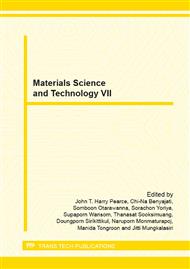[1]
J. Yeom et al., Microfabrication and characterization of a silicon-based millimeter scale, PEM fuel cell operating with hydrogen, methanol, or formic acid, Sensors and Actuators B: Chemical. 107 (2005) 882-891.
DOI: 10.1016/j.snb.2004.12.050
Google Scholar
[2]
S Litster, G. McLean, PEM fuel cell electrodes, Journal of Power Sources. 130 (2004) 61-76.
DOI: 10.1016/j.jpowsour.2003.12.055
Google Scholar
[3]
L. H. Mascaro, D. Gonçalves, L. S. Otávio , Electrocatalytic properties and electrochemical stability of polyaniline and polyaniline modified with platinum nanoparticles in formaldehyde medium, Thin Solid Films. 461 (2004) 243-249.
DOI: 10.1016/j.tsf.2004.01.084
Google Scholar
[4]
K. Bouzek, K. M. Mangold, K. Jãttner, Electrocatalytic Activity of Platinum modified Polypyrrole Films for the Methanol Oxidation reaction, Journal of Applied Electrochemistry. 31, (2001) 501-507.
Google Scholar
[5]
A. Ramanavicius, A. Ramanaviciene, A. Malinauskas, Electrochemical sensors based on conducting polymer-polypyrrole, Electrochimica Acta. 51 (2006) 6025-6037.
DOI: 10.1016/j.electacta.2005.11.052
Google Scholar
[6]
S. Roth, Conductive polymers, Physica B+C, 127 (1984) 151-157.
Google Scholar
[7]
M. Gerard, A. Chaubey, B. D. Malhotra, Application of conducting polymers to biosensors, Biosensors and Bioelectronics. 17 (2002) 345-359.
DOI: 10.1016/s0956-5663(01)00312-8
Google Scholar
[8]
A. F. Diaz, K. K. Kanazawa, G. P. Gardini, Electrochemical polymerization of pyrrole, J. Chem. Soc., Chem. Commun. 14 (1979) 635-636.
DOI: 10.1039/c39790000635
Google Scholar
[9]
L. Li, F. Yan, G. Xue, Preparation of a porous conducting polymer film by electrochemical synthesis, Journal of Applied Polymer Science, 91 (2004) 303-307.
DOI: 10.1002/app.13257
Google Scholar
[10]
J. Liu, S. Mu, The electrochemical polymerization of methylene blue and properties of polymethylene blue, Synthetic Metals. 107 (1999) 159-165.
DOI: 10.1016/s0379-6779(99)00146-0
Google Scholar
[11]
Y. Wang and N. O. Derek, An investigation into polypyrrole-coated 316L stainless steel as a bipolar plate material for PEM fuel cells, Journal of Power Sources, 163 (2006) 500-508.
DOI: 10.1016/j.jpowsour.2006.09.048
Google Scholar


